Enhanced Strength and Plasticity of CoCrNiAl0.1Si0.1 Medium Entropy Alloy via Deformation Twinning and Microband at Cryogenic Temperature
Abstract
:1. Introduction
2. Experiment and Methods
3. Results and Discussion
3.1. Initial Microstructure Analyses
3.2. Mechanical Properties
3.3. Microstructure Characterization
3.4. The Temperature Dependence Yield Strengths
3.5. The Temperature Dependence of Strain Hardening
4. Conclusions
- CoCrNiAl0.1Si0.1 exhibited remarkable simultaneous enhancement of strength and ductility at low temperature. The yield strength increased from 480 MPa to 700 MPa; moreover, the ultimate tensile strength increased from 950 MPa to 1250 MPa. Meanwhile, the elongation reached from 58% to 72% tested at 298 K and 77 K, respectively.
- CoCrNiAl0.1Si0.1 severe lattice distortion inducted Peierls lattice friction stress. The Peierls barrier height increased with decreasing temperature, owing to thermal vibrations, causing the effective width of a dislocation core to decrease. Meanwhile, the presence of co-clustering and/or SRO were the sources of thermal obstacles to dislocation motion, which contributed to the temperature dependence of yield stress.
- At 298 K, the main deformation mechanism of CoCrNiAl0.1Si0.1 was the dislocation cells, deformation twins, and interactions of twins and dislocation. At 77 K, it was attributed to multiple mechanisms work together to the high-density dislocation, the increased volume fraction of nano-twins, secondary nano-twins, and microbands, which facilitated the continuous strain hardening and remarkable plastic deformation.
Author Contributions
Funding
Institutional Review Board Statement
Informed Consent Statement
Data Availability Statement
Acknowledgments
Conflicts of Interest
References
- Yeh, J.W.; Chen, S.K.; Lin, S.J.; Gan, J.Y.; Chin, T.S.; Shun, T.T.; Tsau, C.H.; Chang, S.Y. Nanostructured High-Entropy Alloys with Multiple Principal Elements: Novel Alloy Design Concepts and Outcomes. Adv. Eng. Mater. 2004, 6, 299–303. [Google Scholar] [CrossRef]
- Gludovatz, B.; Hohenwarter, A.; Thurston, K.V.; Bei, H.; Wu, Z.; George, E.P.; Ritchie, R.O. Exceptional damage-tolerance of a medium-entropy alloy CrCoNi at cryogenic temperatures. Nat. Commun. 2016, 7, 10602. [Google Scholar] [CrossRef] [PubMed]
- Yeh, J.-W.; Lin, S.-J. Breakthrough applications of high-entropy materials. J. Mater. Res. 2018, 33, 3129–3137. [Google Scholar] [CrossRef]
- Mishra, R.K.; Sahay, P.P.; Shahi, R.R. Alloying, magnetic and corrosion behavior of AlCrFeMnNiTi high entropy alloy. J. Mater. Sci. 2019, 54, 4433–4443. [Google Scholar] [CrossRef]
- Bouaziz, O.; Allain, S.; Scott, C.P.; Cugy, P.; Barbier, D. High manganese austenitic twinning induced plasticity steels: A review of the microstructure properties relationships. Curr. Opin. Solid State Mater. Sci. 2011, 15, 141–168. [Google Scholar] [CrossRef]
- Laplanche, G.; Kostka, A.; Reinhart, C.; Hunfeld, J.; Eggeler, G.; George, E.P. Reasons for the superior mechanical properties of medium-entropy CrCoNi compared to high-entropy CrMnFeCoNi. Acta Mater. 2017, 128, 292–303. [Google Scholar] [CrossRef]
- Wu, Z.; Bei, H.; Pharr, G.M.; George, E.P. Temperature dependence of the mechanical properties of equiatomic solid solution alloys with face-centered cubic crystal structures. Acta Mater. 2014, 81, 428–441. [Google Scholar] [CrossRef]
- Li, Q.; Zhang, T.W.; Qiao, J.W.; Ma, S.G.; Zhao, D.; Lu, P.; Wang, Z.H. Mechanical properties and deformation behavior of dual-phase Al0.6CoCrFeNi high-entropy alloys with heterogeneous structure at room and cryogenic temperatures. J. Alloys Compd. 2020, 816, 152663. [Google Scholar] [CrossRef]
- Li, Q.; Zhang, T.W.; Qiao, J.W.; Ma, S.G.; Zhao, D.; Lu, P.; Xu, B.; Wang, Z.H. Superior tensile properties of Al0.3CoCrFeNi high entropy alloys with B2 precipitated phases at room and cryogenic temperatures. Mater. Sci. Eng. A 2019, 767, 138424. [Google Scholar] [CrossRef]
- Zhao, Y.L.; Yang, T.; Tong, Y.; Wang, J.; Luan, J.H.; Jiao, Z.B.; Chen, D.; Yang, Y.; Hu, A.; Liu, C.T.; et al. Heterogeneous precipitation behavior and stacking-fault-mediated deformation in a CoCrNi-based medium-entropy alloy. Acta Mater. 2018, 138, 72–82. [Google Scholar] [CrossRef]
- Seo, W.; Jeong, D.; Sung, H.; Kim, S. Tensile and high cycle fatigue behaviors of high-Mn steels at 298 and 110 K. Mater. Charact. 2017, 124, 65–72. [Google Scholar] [CrossRef]
- Wang, Z.; Baker, I.; Guo, W.; Poplawsky, J.D. The effect of carbon on the microstructures, mechanical properties, and deformation mechanisms of thermo-mechanically treated Fe40.4Ni11.3Mn34.8Al7.5Cr6 high entropy alloys. Acta Mater. 2017, 126, 346–360. [Google Scholar] [CrossRef] [Green Version]
- Schneider, M.; George, E.P.; Manescau, T.J.; Záležák, T.; Hunfeld, J.; Dlouhý, A.; Eggeler, G.; Laplanche, G. Analysis of strengthening due to grain boundaries and annealing twin boundaries in the CrCoNi medium-entropy alloy. Int. J. Plast. 2020, 124, 155–169. [Google Scholar] [CrossRef]
- Chang, H.; Zhang, T.W.; Ma, S.G.; Zhao, D.; Xiong, R.L.; Wang, T.; Li, Z.Q.; Wang, Z.H. Novel Si-added CrCoNi medium entropy alloys achieving the breakthrough of strength-ductility trade-off. Mater. Des. 2021, 197, 109202. [Google Scholar] [CrossRef]
- Wu, Z.; Gao, Y.; Bei, H. Thermal activation mechanisms and Labusch-type strengthening analysis for a family of high-entropy and equiatomic solid-solution alloys. Acta Mater. 2016, 120, 108–119. [Google Scholar] [CrossRef] [Green Version]
- Tirunilai, A.S.; Hanemann, T.; Reinhart, C.; Tschan, V.; Weiss, K.P.; Laplanche, G.; Freudenberger, J.; Heilmaier, M.; Kauffmann, A. Comparison of cryogenic deformation of the concentrated solid solutions CoCrFeMnNi, CoCrNi and CoNi. Mater. Sci. Eng. A 2020, 783, 139290. [Google Scholar] [CrossRef]
- Sathiyamoorthi, P.; Moon, J.; Bae, J.W.; Asghari-Rad, P.; Kim, H.S. Superior cryogenic tensile properties of ultrafine-grained CoCrNi medium-entropy alloy produced by high-pressure torsion and annealing. Scr. Mater. 2019, 163, 152–156. [Google Scholar] [CrossRef]
- Liu, T.K.; Wu, Z.; Stoica, A.D.; Xie, Q.; Wu, W.; Gao, Y.F.; Bei, H.; An, K. Twinning-mediated work hardening and texture evolution in CrCoFeMnNi high entropy alloys at cryogenic temperature. Mater. Des. 2017, 131, 419–427. [Google Scholar] [CrossRef]
- Otto, F.; Dlouhý, A.; Somsen, C.; Bei, H.; Eggeler, G.; George, E.P. The influences of temperature and microstructure on the tensile properties of a CoCrFeMnNi high-entropy alloy. Acta Mater. 2013, 61, 5743–5755. [Google Scholar] [CrossRef] [Green Version]
- Ding, Q.; Fu, X.; Chen, D.; Bei, H.; Gludovatz, B.; Li, J.; Zhang, Z.; George, E.P.; Yu, Q.; Zhu, T.; et al. Real-time nanoscale observation of deformation mechanisms in CrCoNi-based medium- to high-entropy alloys at cryogenic temperatures. Mater. Today 2019, 25, 21–27. [Google Scholar] [CrossRef]
- Hong, S.I.; Moon, J.; Hong, S.K.; Kim, H.S. Thermally activated deformation and the rate controlling mechanism in CoCrFeMnNi high entropy alloy. Mater. Sci. Eng. A 2017, 682, 569–576. [Google Scholar] [CrossRef]
- Liu, X.; Pei, Z.; Eisenbach, M. Dislocation core structures and Peierls stresses of the high-entropy alloy NiCoFeCrMn and its subsystems. Mater. Des. 2019, 180, 107955. [Google Scholar] [CrossRef]
- Mishra, R.S.; Kumar, N.; Komarasamy, M. Lattice strain framework for plastic deformation in complex concentrated alloys including high entropy alloys. Mater. Sci. Technol. 2015, 31, 1259–1263. [Google Scholar] [CrossRef]
- Salama, E.; Eissa, M.M.; Tageldin, A.S. Distinct properties of tungsten austenitic stainless alloy as a potential nuclear engineering material. Nucl. Eng. Technol. 2019, 51, 784–791. [Google Scholar] [CrossRef]
- Liu, S.F.; Wu, Y.; Wang, H.T.; He, J.Y.; Liu, J.B.; Chen, C.X.; Liu, X.J.; Wang, H.; Lu, Z.P. Stacking fault energy of face-centered-cubic high entropy alloys. Intermetallics 2018, 93, 269–273. [Google Scholar] [CrossRef]
- Zhang, T.W.; Ma, S.G.; Zhao, D.; Wu, Y.C.; Zhang, Y.; Wang, Z.H.; Qiao, J.W. Simultaneous enhancement of strength and ductility in a NiCoCrFe high-entropy alloy upon dynamic tension: Micromechanism and constitutive modeling. Int. J. Plast. 2020, 124, 226–246. [Google Scholar] [CrossRef]
- Basu, I.; De Hosson, J.T.M. Strengthening mechanisms in high entropy alloys: Fundamental issues. Scr. Mater. 2020, 187, 148–156. [Google Scholar] [CrossRef]
- Wang, Y.; Liu, B.; Yan, K.; Wang, M.; Kabra, S.; Chiu, Y.-L.; Dye, D.; Lee, P.D.; Liu, Y.; Cai, B. Probing deformation mechanisms of a FeCoCrNi high-entropy alloy at 293 and 77 K using in situ neutron diffraction. Acta Mater. 2018, 154, 79–89. [Google Scholar] [CrossRef]
- Lyu, Z.; Fan, X.; Lee, C.; Wang, S.-Y.; Feng, R.; Liaw, P.K. Fundamental understanding of mechanical behavior of high-entropy alloys at low temperatures: A review. J. Mater. Res. 2018, 33, 2998–3010. [Google Scholar] [CrossRef] [Green Version]
- Ma, Y.; Yuan, F.; Yang, M.; Jiang, P.; Ma, E.; Wu, X. Dynamic shear deformation of a CrCoNi medium-entropy alloy with heterogeneous grain structures. Acta Mater. 2018, 148, 407–418. [Google Scholar] [CrossRef] [Green Version]
- Wang, Z.; Bei, H.; Baker, I. Microband induced plasticity and the temperature dependence of the mechanical properties of a carbon-doped FeNiMnAlCr high entropy alloy. Mater. Charact. 2018, 139, 373–381. [Google Scholar] [CrossRef]
- Foley, D.L.; Huang, S.H.; Anber, E.; Shanahan, L.; Shen, Y.; Lang, A.C.; Barr, C.M.; Spearot, D.; Lamberson, L.; Taheri, M.L. Simultaneous twinning and microband formation under dynamic compression in a high entropy alloy with a complex energetic landscape. Acta Mater. 2020, 200, 1–11. [Google Scholar] [CrossRef]
- Jian, W.-R.; Xie, Z.; Xu, S.; Su, Y.; Yao, X.; Beyerlein, I.J. Effects of lattice distortion and chemical short-range order on the mechanisms of deformation in medium entropy alloy CoCrNi. Acta Mater. 2020, 199, 352–369. [Google Scholar] [CrossRef]
- Komarasamy, M.; Kumar, N.; Mishra, R.S.; Liaw, P.K. Anomalies in the deformation mechanism and kinetics of coarse-grained high entropy alloy. Mater. Sci. Eng. A 2016, 654, 256–263. [Google Scholar] [CrossRef]
- Naeem, M.; He, H.; Harjo, S.; Kawasaki, T.; Zhang, F.; Wang, B.; Lan, S.; Wu, Z.; Wu, Y.; Lu, Z.; et al. Extremely high dislocation density and deformation pathway of CrMnFeCoNi high entropy alloy at ultralow temperature. Scr. Mater. 2020, 188, 21–25. [Google Scholar] [CrossRef]
- Yin, B.; Yoshida, S.; Tsuji, N.; Curtin, W.A. Yield strength and misfit volumes of NiCoCr and implications for short-range-order. Nat. Commun. 2020, 11, 2507. [Google Scholar] [CrossRef]
- Guo, W.; Su, J.; Lu, W.; Liebscher, C.H.; Kirchlechner, C.; Ikeda, Y.; Körmann, F.; Liu, X.; Xue, Y.; Dehm, G. Dislocation-induced breakthrough of strength and ductility trade-off in a non-equiatomic high-entropy alloy. Acta Mater. 2020, 185, 45–54. [Google Scholar] [CrossRef]
- Chang, H.; Zhang, T.W.; Ma, S.G.; Zhao, D.; Xiong, R.L.; Wang, T.; Li, Z.Q.; Wang, Z.H. SGTE Data for Pure Elements, Bin. Syst. Part 1 _ Elem. Bin. Syst. from Ag-Al to Au-Tl. Mater. Des. 2005, 197, 1–5. [Google Scholar] [CrossRef]
- Inden, G. The role of magnetism in the calculation of phase diagrams. Phys. B+C 1981, 103, 82–100. [Google Scholar] [CrossRef]
- Ishida, K. Direct estimation of stacking fault energy by thermodynamic analysis. Phys. Status Solidi A 1979, 36, 717. [Google Scholar] [CrossRef]
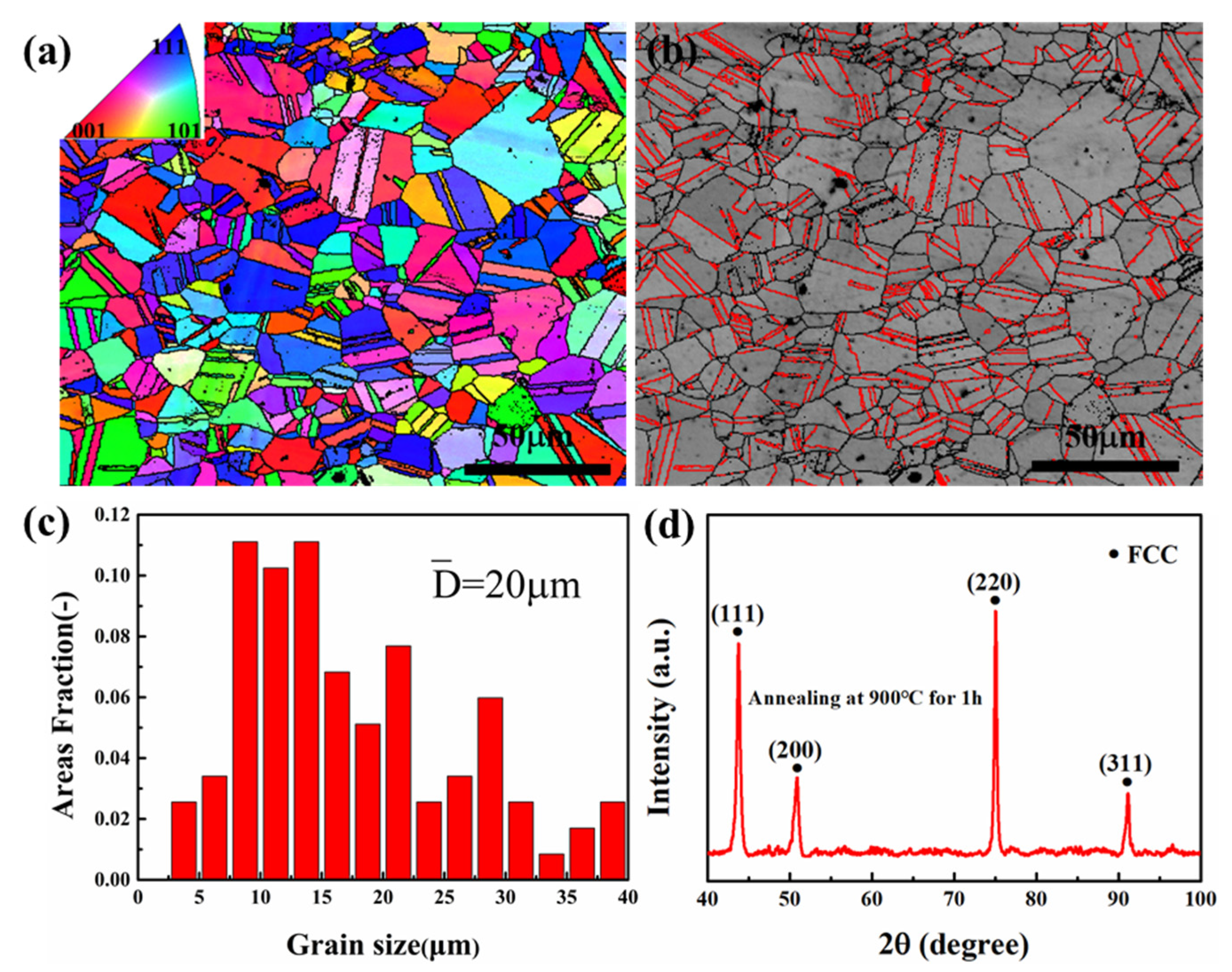
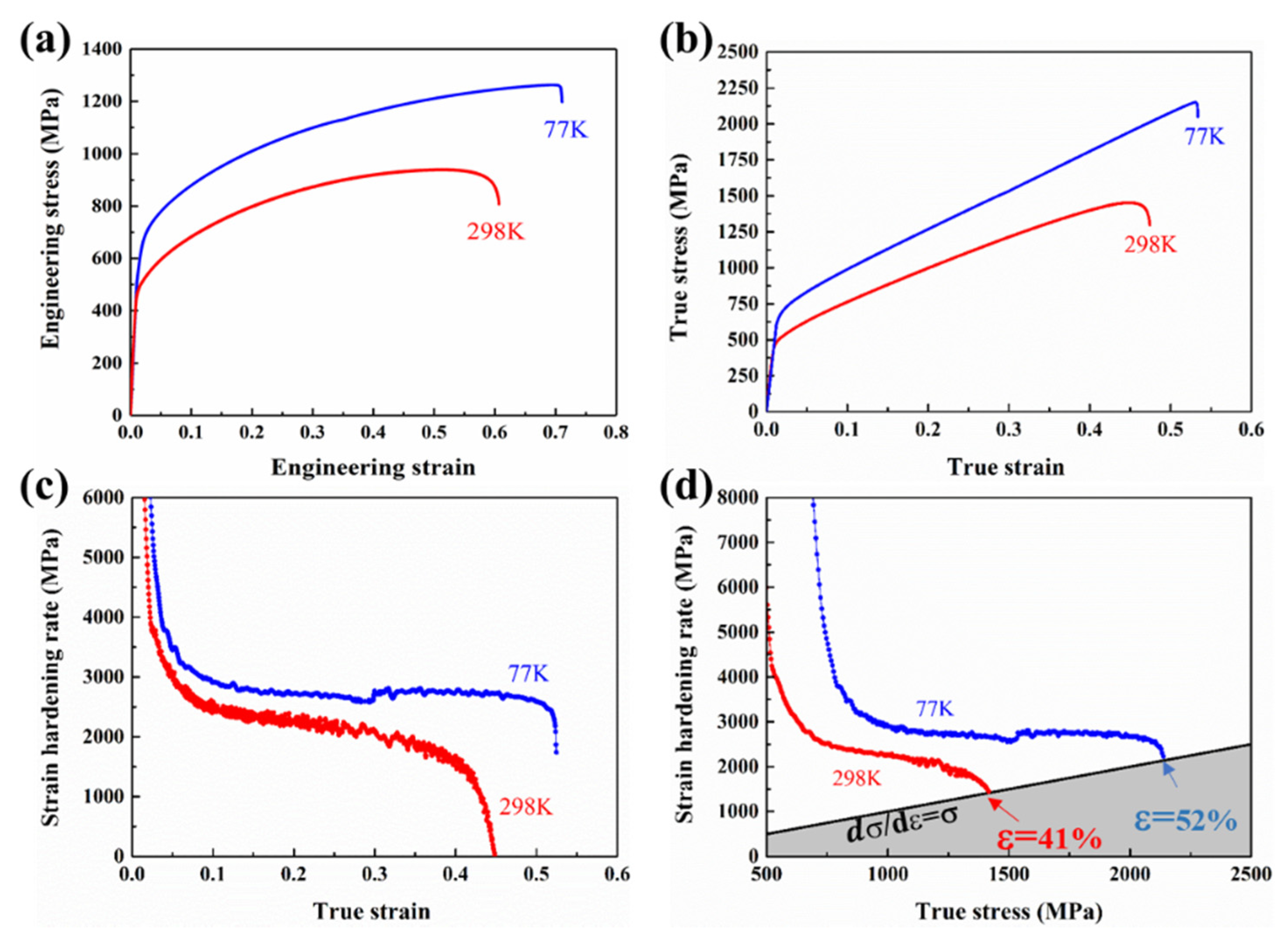

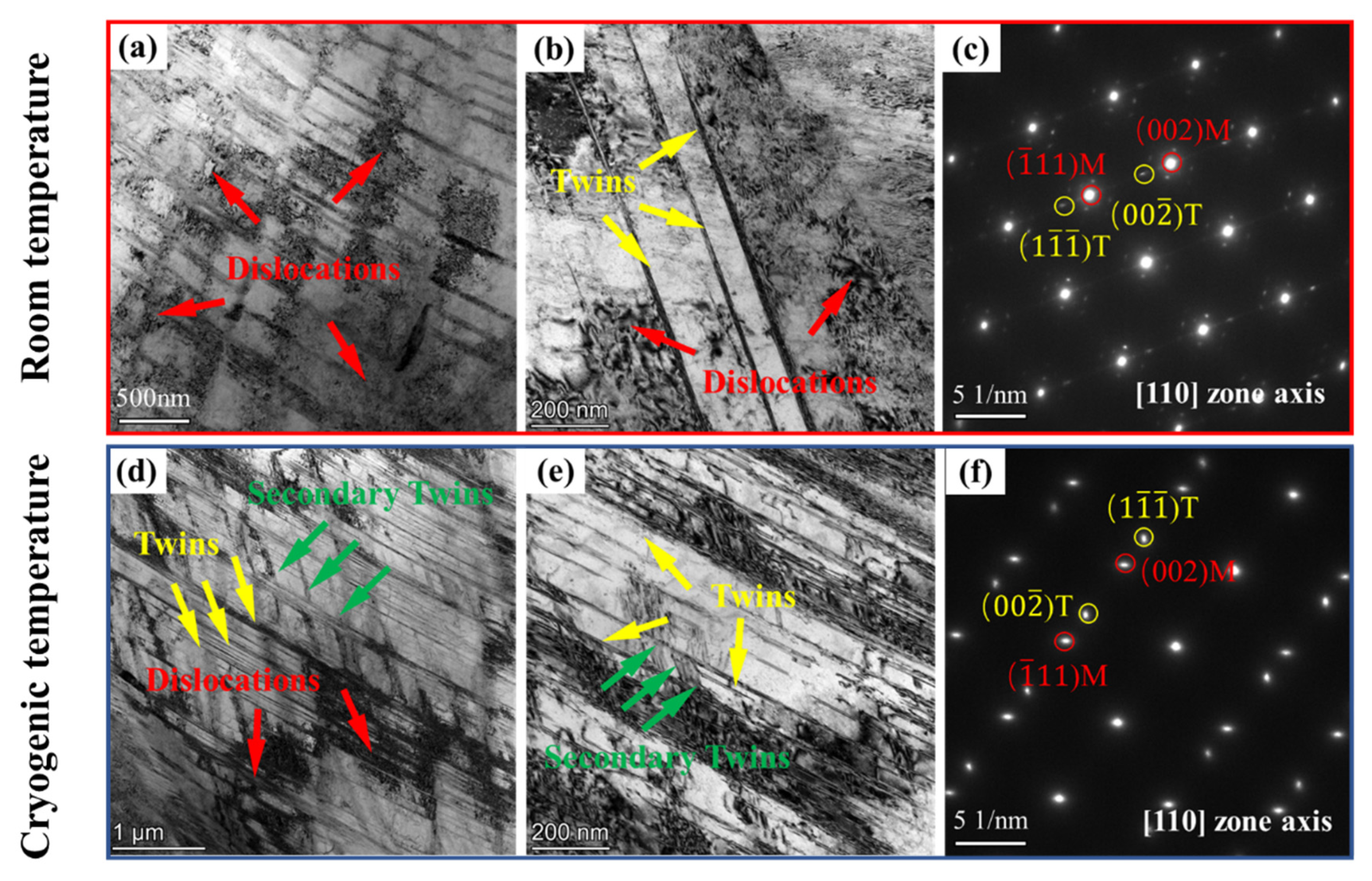
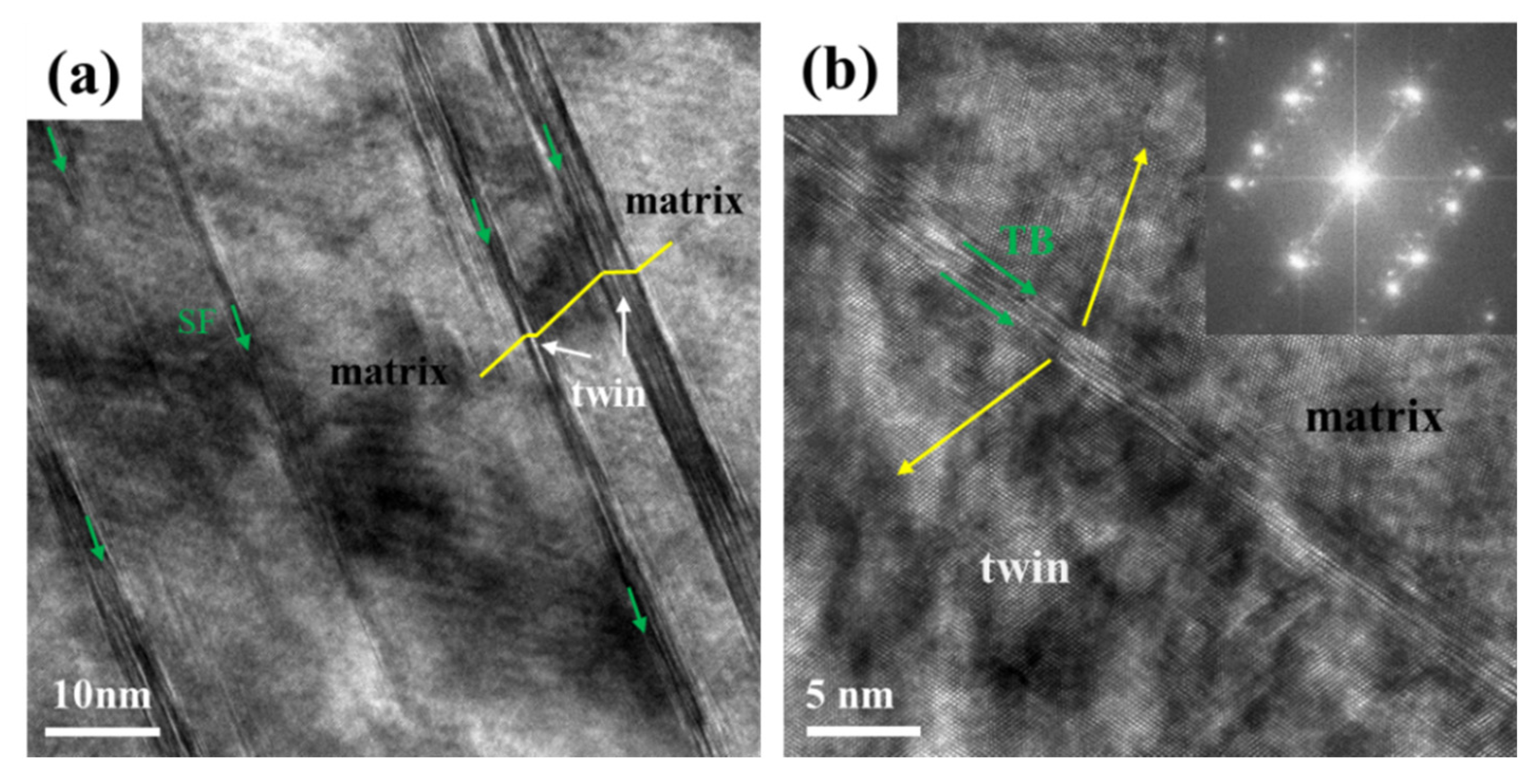
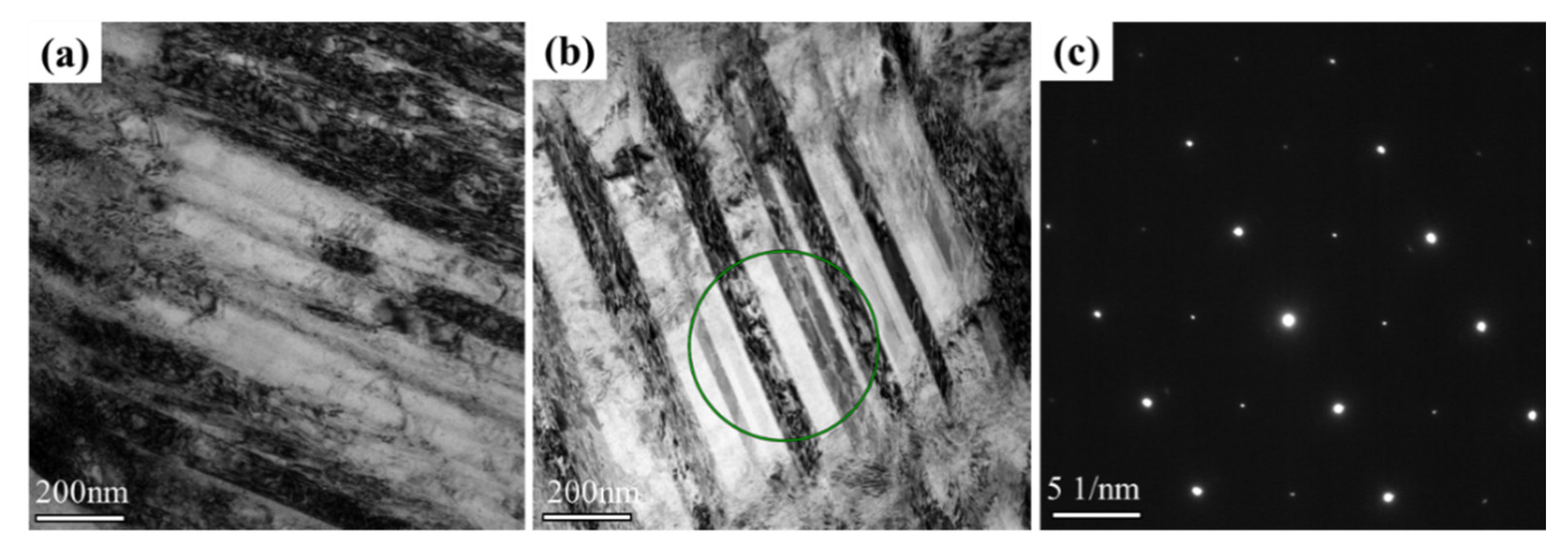
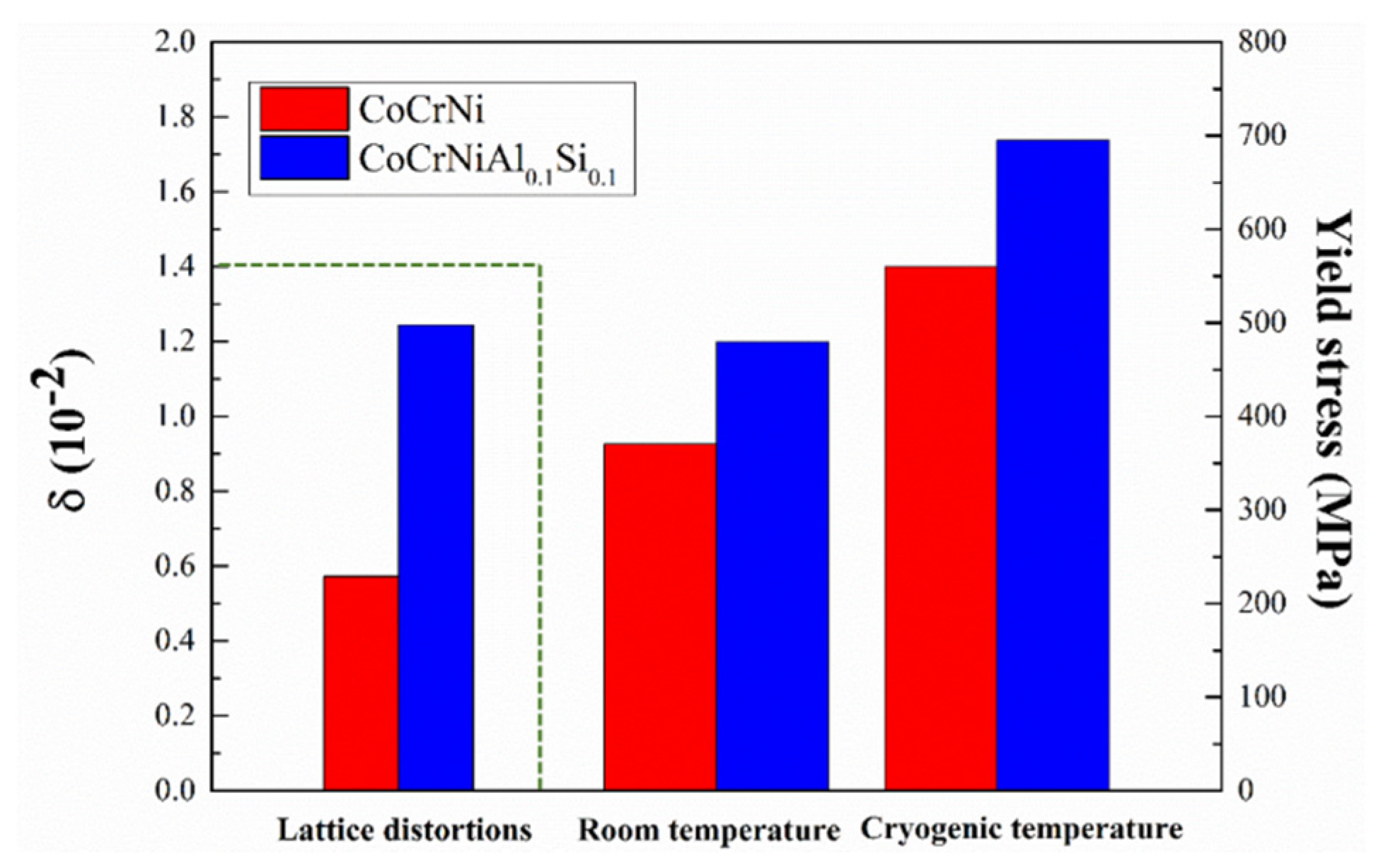

| Alloy | Co | Cr | Ni | Al | Si |
|---|---|---|---|---|---|
| CoCrNiAl0.1Si0.1 | 32.13% | 31.29% | 30.54% | 3.11% | 2.93% |
| Alloys | σy(MPa) | σUTS(MPa) | ε |
|---|---|---|---|
| 298 K | 480 | 900 | 58% |
| 77 K | 700 | 1250 | 72% |
Publisher’s Note: MDPI stays neutral with regard to jurisdictional claims in published maps and institutional affiliations. |
© 2021 by the authors. Licensee MDPI, Basel, Switzerland. This article is an open access article distributed under the terms and conditions of the Creative Commons Attribution (CC BY) license (https://creativecommons.org/licenses/by/4.0/).
Share and Cite
Gu, X.-H.; Meng, Y.-Q.; Chang, H.; Bai, T.-X.; Ma, S.-G.; Zhang, Y.-Q.; Song, W.-D.; Li, Z.-Q. Enhanced Strength and Plasticity of CoCrNiAl0.1Si0.1 Medium Entropy Alloy via Deformation Twinning and Microband at Cryogenic Temperature. Materials 2021, 14, 7574. https://doi.org/10.3390/ma14247574
Gu X-H, Meng Y-Q, Chang H, Bai T-X, Ma S-G, Zhang Y-Q, Song W-D, Li Z-Q. Enhanced Strength and Plasticity of CoCrNiAl0.1Si0.1 Medium Entropy Alloy via Deformation Twinning and Microband at Cryogenic Temperature. Materials. 2021; 14(24):7574. https://doi.org/10.3390/ma14247574
Chicago/Turabian StyleGu, Xiao-Hua, Yu-Quan Meng, Hui Chang, Tian-Xiang Bai, Sheng-Guo Ma, Yong-Qiang Zhang, Wei-Dong Song, and Zhi-Qiang Li. 2021. "Enhanced Strength and Plasticity of CoCrNiAl0.1Si0.1 Medium Entropy Alloy via Deformation Twinning and Microband at Cryogenic Temperature" Materials 14, no. 24: 7574. https://doi.org/10.3390/ma14247574
APA StyleGu, X.-H., Meng, Y.-Q., Chang, H., Bai, T.-X., Ma, S.-G., Zhang, Y.-Q., Song, W.-D., & Li, Z.-Q. (2021). Enhanced Strength and Plasticity of CoCrNiAl0.1Si0.1 Medium Entropy Alloy via Deformation Twinning and Microband at Cryogenic Temperature. Materials, 14(24), 7574. https://doi.org/10.3390/ma14247574






